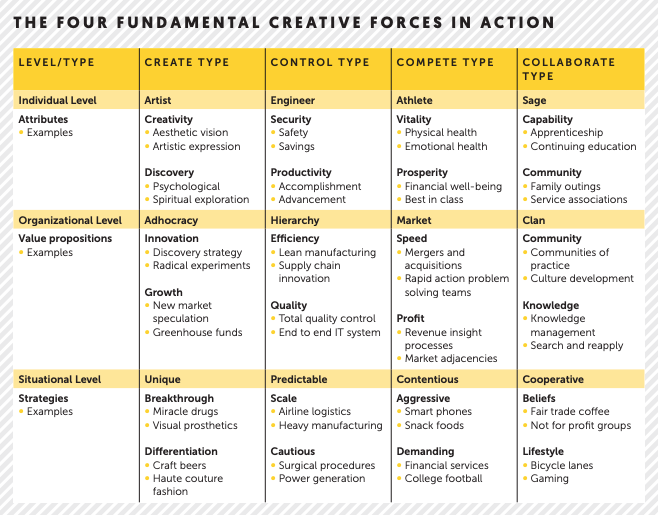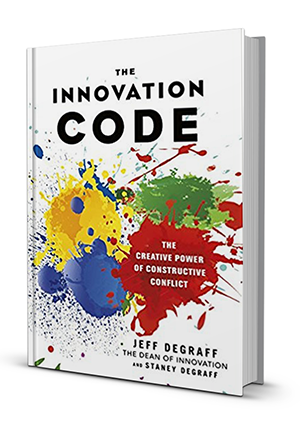Is ambidextrous leadership simply an updated version of the old catchphrase ‘a jack of all trades and a master of none’? In this age of specialization, is having an expanded range and repertoire more desirable than deep-domain expertise?
Ambidexterity poses a fundamental challenge in the field of innovation where one size seldom fits all. It is doubtful that a master product designer of military aircraft would be equally as skilled at creating a fine dining restaurant. What constitutes effective leadership skills is typically defined by the situation.
A truly ambidextrous leader would be something akin to a polymath like Leonardo da Vinci or Benjamin Franklin. Alternatively, vague conceptions of the term as an attribute of effective leadership are of limited significance because they tell us little about how such skills specifically create results.
Truly ambidextrous leaders are rare. Those that fit the bill are often mythologized, like Steve Jobs. It might be more useful to consider ambidexterity as a mindset instead of a set of abilities. Thus, it will be within the reach of more leaders.
The late professor of corporate strategy CK Prahalad coined the term ‘dominant logic’ to describe the culture and beliefs an organization espouses that inadvertently informs its strategy and development. Put another way, organizations have a limited worldview. This lack of awareness creates blind spots which bring unintended, and often unpleasant, consequences. So, how can we learn to see what is in our blind spots?
The answer is that we must seek out conflict. But we must seek the right kind of conflict, and in the right way. We need to engage the loyal opposition to help us locate the limits of our thinking, and so adopt an ambidextrous mindset.
The creative power of constructive conflict
There are multiple types of interpersonal conflict relevant to ambidextrous leadership. To keep things positive, most methods of conflict management focus on three aspects of interactions. First, they cite the inevitability of conflict in all healthy human relationships. Passive aggressive behavior, often taken as conformity, is viewed as a sign of a destructive environment. Second, they emphasize keeping the conflict centered on opinions and ideas; not personalities. Ad hominem attacks quickly escalate differences into negative actions. Third, team doctors like Patrick Lencioni suggest that conflict moves along a continuum between artificial harmony – such as groupthink – and divisive arguments that disguise deeper power issues. In short, the key is to create positive tension by challenging ideas, not people.
It might be more useful to consider ambidexterity as a mindset instead of a set of abilities
The idea that constructive conflict produces innovative solutions, hybrids born from opposing ideas, is an old one. Ancient Chinese Daoist philosophy characterizes universal forces as yin and yang, seemingly antagonistic energies that are interconnected. Similarly, the eminent 18th-century German philosopher GWF Hegel saw history progressing as an ever-advancing dialectic of thesis and antithesis, ultimately resulting in a synthesis of something altogether new. In both Daoism and Hegelianism, constructive conflict is considered natural and inevitable.
Often overlooked is the role the creative power of constructive conflict plays in theories of economics that still influence our thinking today:
- Adam Smith Conflict between competitors in the market produces better and cheaper goods and services
- Karl Marx Conflict between the ruling class and working class produces creative destruction leading to a more equitable social order
- Joseph Schumpeter Conflict between incumbent and start-up institutions creates innovative new industries and destroys old ineffective ones
Although espousing a significantly different ethos and end game, each view posits conflict as the generative force that moves us forward.
So, how is an ambidextrous leader, one focused on ideas and not personalities, to put the creative power of constructive conflict to work? First, they need a heuristic process – a cognitive map and mindset – to characterize differences in terms of recognizable types and associated conditions in which they typically excel or falter. Second, ambidextrous leaders need a process by which they can encounter, enlist and engage diverse and contrasting types.
The Innovation Genome
The Innovation Genome, an offspring of the Competing Values Framework, is a meta-model upon which a wide variation of leadership types can be compared and evaluated. The Innovation Genome has three levels and four types:
Levels
- Situational: The world at large imposing demands on the organization (e.g. recessions, conflicts, pandemics, shortages)
- Organizational: A community with a shared identity, values, and aspirations (e.g. company, not-for-profit, family, social media network)
- Individual: A person with abilities, skills and attitudes both naturally developed, as well as those derived from experiences and orientation (e.g. parenting, education, relationships, wellbeing)
These three levels are interrelated. Think of them like Russian nesting dolls. Each level is subsumed by the greater level.
Whereas most leadership-type indicators assume that the situation in which leaders lead is neutral, the Innovation Genome does not. Just as some investors prosper in bull markets while others succeed in bear markets, what makes an effective leader is determined almost entirely by the strategic situation.
Value propositions such as profitable growth are achieved when an organization develops the appropriate culture and competencies to produce them. In turn, the appropriate culture and competencies are developed by leaders. Essentially, scalable innovation competencies and culture are determined by how well leaders diagnose the situation and synchronize the organization to pursue and produce specific value propositions.
Ironically, while there are clear connections between outcomes and the organizational culture and capability required to capture them, leaders typically favor practices that closely resemble their own preferences and therefore actually may destroy growth. In other words, they prefer the tools, methods, and people who are more like them over those that will help them innovate.

Types There are four fundamental creative forces that produce value by pulling us, our communities, the imperceptible zeitgeist and all the constituents in our situations in different directions (also see table above):
- Create Artist Leader
- Control Engineer Leader
- Compete Athlete Leader
- Collaborate Sage Leader
These four creative forces drive or thwart growth in dyadic oppositions:
- Collaborate versus Compete
- Create versus Control
This constructive conflict between types produces the generative power. Leaders with an ambidextrous mindset, who can take a higher point of view, see their own strengths and weaknesses, and know when and how to enlist others with different skills, are essential for harnessing the creative power of constructive conflict.
By focusing on shared vision and goals, the ambidextrous leader can redirect tension to more productive ends
While no leader is just one type, they do gravitate toward a dominant logic. Think of it like being right- or left-handed. To understand a leader’s true type, pay attention to what they do when under duress. So, what steps can a leader with an ambidextrous mindset take to make innovation happen?
Process
There are four steps to harnessing the creative power of constructive conflict:
- Assemble a diversity of perspectives Diversity goes well beyond gender or ethnicity and include aspects such as domain expertise, belief systems, and life experiences.
- Engage in the conflict Even in a diverse workspace or digital social media network, it’s easy to avoid or even ‘unfriend’ those whose worldviews we find disagreeable.
- Establish a shared vision or goal Paradoxically, the result people want to achieve is often confused with the approach they take to achieving it. By focusing on the vision and goals they share, the ambidextrous leader can redirect these tensions to more productive ends.
- Construct hybrid solutions Finally, the payout of harnessing these positive tensions is the creation of innovative hybrid solutions. This stage is typically iterative, and requires a great deal of ongoing adjustment.
Let’s explore the creative power of constructive conflict via a case study of an organization that needed to quickly reinvent itself by way of innovation.
In the late 1990s, the international news agency and technology company Reuters found itself in financial trouble. It had operated largely as a British concern for over a century, with most of its executives coming from relatively similar backgrounds. The dot.com bust had put the firm in a perilous situation, and the board decided to make a change at the top. They appointed Tom Glocer chief executive, the first American to ever lead the venerable establishment.
Assemble a diversity of perspectives
Glocer started by having his own skills, attitudes, and disposition objectively evaluated to become more self-aware of his abilities and biases. Next, he asked his executive team to do the same and an in-depth report was created for each. A more global and technologically sophisticated mindset was needed. So, he adjusted his team to bring in this new and diverse set of skills.
Engage in the conflict
Glocer encouraged respectful disagreement, and the culture of quiet dissent started to give way to a more vocal form of constructive conflict. Was Reuters a news organization or an information technology development company? Though the real concerns of the company were now being discussed, Glocer was troubled that the new executive team was beginning to form factions. He, therefore, rearranged offices so that those with most contentious points of view were seated near each other. This way they would have to routinely confront their differences every day.
Establish a shared vision or goal
Glocer added elements to both the board and executive team meetings that encouraged meaningful dissent in the strategic planning process. Meetings began to drag on into the night, but with an open mind, the team was finding the root cause of their challenges and discovering new market opportunities.
A shared vision that they all owned began to emerge, but the strategy and timeline given to investors would need to be adjusted to allow the time they needed to achieve it. In an unprecedented move, Glocer went to the unforgiving financial community and made his case.
Construct hybrid solutions
Glocer had enlisted and engaged his executive team, board and investors. What he needed now was the company at large – their ideas, their support, and their ability to get it done. So, Glocer convened a massive innovation jumpstart in an old lorry warehouse in an industrial borough of London.
More than 100 leaders from around the world, as well as their best and brightest minds, were invited to develop breakthrough new products and services, as well as radical solutions to emerging challenges.
The warehouse looked like the floor of the stock exchange. Divergent regions, disciplines and factions began to converge as new hybrid ideas emerged. The usually understated chairman of the board proclaimed the output “astounding”. Reuters had the ability to innovate all along. It just needed to unleash its generative energy of constructive conflict.
The story doesn’t end here. There were years of layoffs, product failures, and a wide array of disappointments. But, Reuters was saved by the aspirations of its leaders to use an ambidextrous approach to make innovation happen.
Eventually, the firm was acquired by Thomson, and – in a highly unusual move – Glocer was made chief executive of the digital media giant before he stepped down years later.
Ambidexterity may be more a desired state than an achievable goal. Few among us would qualify as a heroic übermensch leader. As with the performing arts, ambidexterity requires an ensemble.
Originally published in Dialogue Magazine.

Unleash your creativity
Discover the power of constructive conflict and how it can help foster innovation. By reading The Innovation Code, you will learn how to harness tension and transform it into positive energy to successfully implement your innovation projects.

